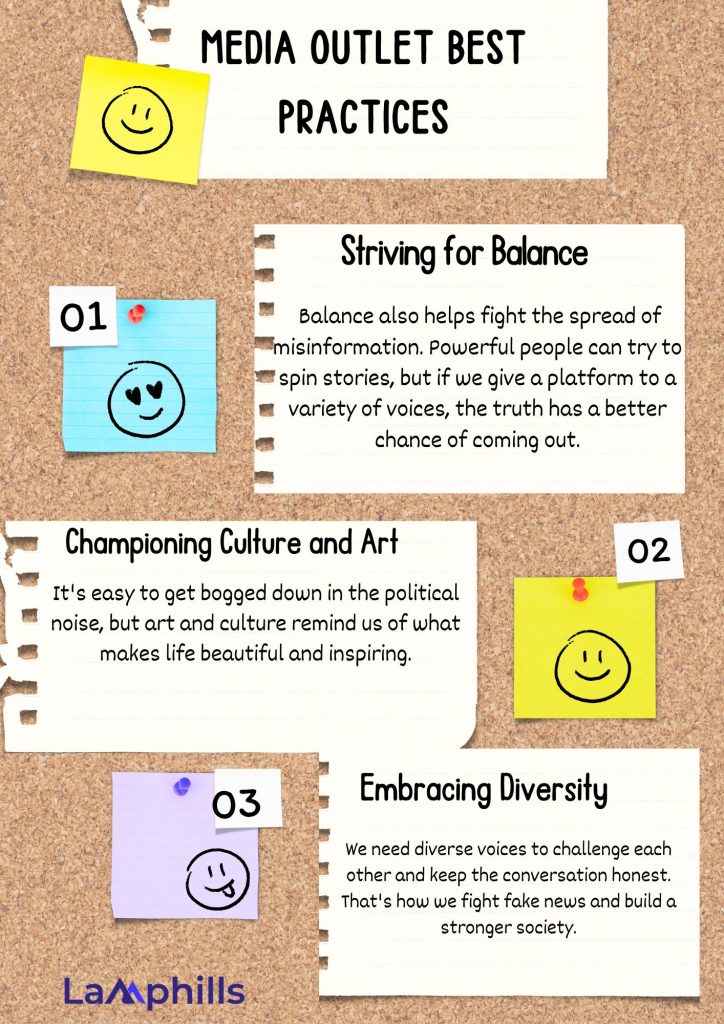In the ever-shifting media landscape, staying informed can feel like chasing a moving target. We all have our preferred sources for news and entertainment, but with so many options out there, how do you know where to start? I’ve spent the past few weeks digging into the data and chatting with fellow news junkies, and I’m here to share the lowdown on the top media outlets dominating the scene in 2024.
From legacy giants to innovative newcomers, get ready to discover a diverse range of platforms guaranteed to keep you in the loop. Whether you crave in-depth analysis, breaking news updates, or insightful documentaries, this guide will equip you with the knowledge to navigate the social media outlet world with confidence. So, grab your favorite beverage, settle in, and let’s give the powerhouses shaping the way we consume information today.
Key Points
- Media outlets aren’t all created equal. Some, like NPR, strive to give you the whole story, all the facts, letting you form your own opinion.
- Whether you’re a passionate photographer showcasing your latest masterpiece on Instagram or a fitness enthusiast sharing workout tips on TikTok, your social media outlet allows you to express yourself and connect with a global audience.
- From the traditional giants like newspapers and TV stations to the new kids on the block like social media platforms, media outlets are the voices that keep us informed and entertained.
- A social media outlet serves as a digital hub for content creation, curation, and interaction.
- Media outlets are the messengers, the platforms that take information and turn it into consumable content for us
Media Outlets
You know that feeling of needing to stay on top of what’s happening in the world? Media outlets are your lifeline for that. They’re the trusted sources, the reporters and commentators, diving deep into the stories that shape our world. Think of them as conversation starters, sparking discussions about the latest developments, the important people, and the events that matter.
It’s not a popularity contest, though. Sure, some outlets are huge, with massive audiences. But what really makes a media outlet stand out is its credibility. Reliable reporting, that’s the gold standard. Then there are the outlets that go the extra mile, providing in-depth analysis, and digging beneath the surface to educate and inform. They’re the ones who make sure you get the whole picture. So, the next time you’re scrolling through the news, take a moment to consider the source. Are they giving you the straight story? Are they unpacking the complexities? In today’s information age, quality journalism is more important than ever.
These are the messengers, the platforms that take information and turn it into consumable content for us. From the traditional giants like newspapers and TV stations to the new kids on the block like social media platforms, media outlets are the voices that keep us informed and entertained.
How a Media Outlet Works
Imagine you’re sitting down with a coffee, flipping through a news app or newspaper. That app or paper? That’s a media outlet, acting as your window to the world. It feeds you information, sure, but it also connects you to others—people going about their lives, facing similar challenges, or just being entertained by the same silly cat video.
Media outlets aren’t all created equal. Some, like NPR, strive to give you the whole story, all the facts, letting you form your own opinion. Think of it as informative journalism—laying everything on the table. Others, though, use a tactic called advocacy journalism. They might spin a story, leaving out details that don’t fit their agenda. It’s like only showing you half the picture.
So, how do you decide which outlets to trust? It’s a good question, especially considering how much power the media has. They can shape public opinion, making people think a certain way about a particular issue. No wonder we’re all a little skeptical these days! We all have our own biases and our own way of seeing the world, and that often influences which media outlets we gravitate towards. Maybe you lean liberal and trust CNN, or perhaps you’re more conservative and find Fox News speaks to you more.
The truth is, though, that media outlets are businesses after all. They need to make money to keep the lights on, and that often means selling ads or subscriptions. This can get tricky. Big companies with a lot to lose might try to sway what news gets reported, and which stories get buried. It’s not always blatant manipulation, but it’s a factor to consider. Even seemingly free platforms like Facebook aren’t immune. They’ve been accused of letting advertisers influence what shows up in your feed, shaping your perspective without you even realizing it.
Social Media Outlets
We all know them—those corners of the internet we frequent to connect, share, and discover. But what exactly are these platforms we use? They’re social media outlets, virtual spaces we create and manage within third-party websites like YouTube and Facebook. Think of them as your personalized storefronts within a bustling online marketplace.
You curate the content, set the tone, and invite others to engage with your unique perspective. Whether you’re a passionate photographer showcasing your latest masterpiece on Instagram or a fitness enthusiast sharing workout tips on TikTok, your social media outlet allows you to express yourself and connect with a global audience.
In essence, a social media outlet serves as a digital hub for content creation, curation, and interaction. It provides a channel through which non-right holders can express their viewpoints, share updates, and engage with their audience. For instance, a non-rights holder YouTube “channel” or a Facebook “fan page” are prime examples of such outlets.

Media Outlet Best Practices
I spend a lot of time thinking about what makes a good media outlet. It’s about more than just getting the news out there. Sure, we all want to keep our audience engaged, but there’s a bigger picture.
#1. Striving for Balance
One of the most important things for me is balance. We can’t just be cheerleaders for one side or the other. People deserve to hear all sides of an issue, even if it’s uncomfortable. That way, they can make up their own minds. Balance also helps fight the spread of misinformation. Powerful people can try to spin stories, but if we give a platform to a variety of voices, the truth has a better chance of coming out.
#2. Championing Culture and Art
Another big one for me is promoting art and culture. It’s easy to get bogged down in the political noise, but art and culture remind us of what makes life beautiful and inspiring. They show us different perspectives and help us understand each other better. Plus, they’re just plain fun!
#3. Embracing Diversity
Diversity is key. It doesn’t matter if I lean left or right; a healthy democracy needs a variety of viewpoints. When everyone hears the same story, it’s easy for manipulation to take root. We need diverse voices to challenge each other and keep the conversation honest. That’s how we fight fake news and build a stronger society.
Lamphills Media Outlets Checklist
Top 20 Media Outlets
The world of news is a vast and ever-evolving landscape. With a constant stream of information bombarding us, staying informed requires navigating a sea of media outlets. But where do you begin? Buckle up, because we’re going deep into the top 20 media outlet powerhouses shaping the way we consume news today.
#1. CNN
The news network practically invented the concept of 24/7 news coverage. Launched in 1980, it’s become a global phenomenon, reaching millions with its breaking news and in-depth reports. Not to mention, it holds the distinction of being the most-watched news channel in the world!
#2. BBC
Across the pond, we encounter the BBC, the titan of British news. Renowned for its journalistic integrity and impartiality, it’s a trusted source for audiences worldwide. Their commitment to global coverage is impressive, with a vast network of correspondents stationed across the globe.
#3. The New York Times
This American institution, established in 1851, has become synonymous with quality journalism. From thought-provoking editorials to in-depth investigative reports, the Times offers a rich tapestry of news and commentary. Their success is evident in their massive digital readership and their impressive collection of Pulitzer Prizes, the “Oscars” of journalism.
#4. Reuters
This is a news agency with a rich history dating back to 1851. They’re the go-to source for reliable breaking news, with a physical presence in nearly 100 countries. Think of them as the invisible puppeteer, supplying news content to countless outlets worldwide.
#5. The Washington Post
This is another American heavyweight and boasts a reputation for investigative journalism and insightful analysis. They’ve been at the forefront of historic moments, most notably breaking the Watergate scandal that led to a President’s resignation. Their commitment to quality has earned them legions of loyal readers and a significant online presence.
#6. Al Jazeera
In the Middle East, we find Al Jazeera, a pioneer in Arabic news broadcasting. Founded in 1996, it challenged the dominance of Western-controlled media. Their dedication to in-depth reporting and diverse perspectives has earned them a global audience and a reputation for quality journalism.
#7. The Guardian
It is a British newspaper known for its award-winning journalism and strong social conscience and is another major player. They’ve carved out a niche with their focus on investigative reporting, opinion pieces, and diverse viewpoints. Their unique ownership structure, which ensures editorial independence, sets them apart from the pack.
#8. Associated Press
The Associated Press (AP), established in 1846, is a news powerhouse with a global reach. They’re one of the oldest and most respected news agencies, supplying news content to thousands of outlets worldwide. Their commitment to accuracy and speed has made them a trusted source for breaking news across the globe.
#9. NBC
Now, let’s shift gears and explore the world of television news. NBC is a household name in America and has been a staple since 1926. They’re one of the “Big Three” American networks, offering a comprehensive range of news programming across various platforms. From breaking news to in-depth analysis, NBC delivers the news in a visually engaging and informative way.
#10. Fox News
Launched in 1996, quickly carved out a niche as the conservative counterpart to CNN. They’ve become a media powerhouse, attracting a loyal audience with their right-wing perspective. Their influence extends beyond television, with successful radio and online platforms.
#11. ABC News
Another American giant boasts a long and illustrious history dating back to 1945. They’re known for their high-quality news programming and award-winning coverage of major events. Their commitment to a strong online and social media presence ensures their audience stays informed and engaged.
#12. Bloomberg
Stepping out of the United States, we encounter Bloomberg, a financial news giant established in 1990. They offer in-depth financial news, industry analysis, and investing insights to a dedicated audience. Their global reach and team of expert reporters make them a go-to source for financial news and analysis.
#13. CBS News
Another American television news pioneer with roots dating back to 1927, has a loyal following. They’ve adapted to the digital age, boasting one of the fastest-growing online news sites. Their ability to cater to both television and online audiences solidifies their position as a major player in the news landscape.
#14. NPR
Public radio takes center stage with NPR (National Public Radio). Unlike its commercial counterparts, NPR focuses on informative storytelling and in-depth analysis. Their emphasis on quality journalism and diverse perspectives makes them a trusted source for many Americans.
#15. Politico
Established in 2006, quickly emerged as a major force in US political journalism. Known for their sharp analysis and insightful reporting, they’ve become a go-to source for those seeking to understand the intricacies of American politics. Their influence extends beyond print, with a strong digital presence and impactful email newsletters.
#16. The Wall Street Journal (WSJ).
For those seeking in-depth financial analysis and business news, look no further than Wall Street Journal (WSJ). Founded in 1889, it’s renowned for its rigorous journalism and commitment to factual reporting. Their detailed coverage of global financial markets, insightful analysis, and fact-checked content make them a trusted source for investors and business leaders alike. While some content sits behind a paywall, their digital presence is undeniable.
#17. TIME Magazine
Established in 1923, needs little introduction. This iconic magazine, recognized for its red-bordered covers featuring influential figures, has cemented its place in media history. They’ve successfully adapted to the digital age, offering insightful analysis and detailed reporting on current events. Their annual “Person of the Year” issue remains a highly anticipated event.
#18. USA Today
Launched in 1982, revolutionized newspaper design with its use of colorful graphics and easily digestible information nuggets. While initially mocked, its format has been widely imitated. Today, it boasts the largest newspaper circulation in the US, with a strong digital presence to complement its print edition.
#19. CNBC
If you crave in-depth business news and market analysis, tune into CNBC. Launched in 1989, it’s one of the “Big Three” business news channels, offering live stock market updates, insightful interviews, and investment guidance. Their global reach and additional programming cater to a dedicated audience of investors and business professionals.
#20. HuffPost
Rounding out our list is HuffPost (formerly The Huffington Post), a popular online news platform known for its blend of breaking news, political commentary, and lifestyle content. They cater to a broad audience with their focus on diverse perspectives, user-generated content (“UGC”), and catchy headlines. Their impact on digital journalism is undeniable, proving that a unique approach can capture a loyal following.
This concludes our whirlwind tour of the top 20 media outlet giants. From established news agencies to digital upstarts, these outlets wield immense power in shaping our understanding of the world. Remember, with such a vast media landscape, it’s crucial to be a discerning consumer of news. By familiarizing yourself with these key players and their approaches, you’ll be well-equipped to navigate the ever-changing world of information.
What Is the Meaning of Mass Media Outlet?
Do you know those channels we rely on for news and entertainment? That’s mass media! It’s like a giant information machine reaching everyone. Think of the newspapers you grab at the store, or the TV shows you catch at night. Radio, magazines, and even the internet are all part of this massive communication system. And it’s how we stay informed as a society. These outlets act like a constant conversation starter, feeding us news, stories, and ideas that shape our understanding of the world.
What Is a Digital Media Outlet?
You have a story to tell, but instead of needing a giant TV network, you can publish it online! That’s what a digital media outlet is all about. These are companies that create content like articles, videos, or podcasts, but instead of relying on traditional media like newspapers or radio, they publish it on their own websites or apps.
They might even build the tools to share that content easily. It’s like having your own personal newsstand, but online! Now, with the internet, anyone can be a publisher. But it’s not just about creating content anymore. Today, the coolest digital media outlets are the ones that control their own platforms, like websites or social media channels. That way, they get to decide how their stories are seen and reach even more people!
Related Posts
The Digital Markets Act (Dma): How It Works.
BEST FREE PRESS RELEASE DISTRIBUTION WEBSITES IN 2024






